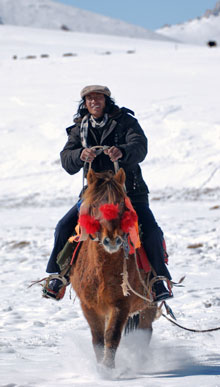Related resources

Tracking the snow leopard
Local herders are central to protecting the snow leopard in the source area of the Yangtze River. J Marc Foggin introduces a series of photos documenting the community conservation project. Slideshow available here.
Tracking Tibet's snow leopards
China Dialogue, 08 November 2011 - In a remote area of Yushu Tibetan Autonomous Prefecture, in China’s western Qinghai province, local Tibetan herders have been actively protecting the snow leopard and other endangered wildlife in the high grasslands and mountains for more than a decade. Now, with help from non-profit organisation, Plateau Perspectives, and the Sanjiangyuan National Nature Reserve, they are also using “camera traps” to photograph the animals and better document their distribution, range and behaviour. The images presented here include some of the first photographs taken.
There are fewer than 7,500 snow leopards worldwide, according to the latest estimates from a dozen countries. Around 60% of this elusive species’ potential habitat is in China, most of it on the Tibetan Plateau. Conservation efforts are crucial and the people of Muqu village are supporting them in several ways, serving as park wardens, environmental advocates and as partners in applied wildlife research.
Such commitment to environmental protection is rooted in the community’s involvement in a more people-centred approach to environmental management, known as “community co-management”. When locals are treated as genuine partners and allowed to voice their concerns as well as sharing their knowledge, there is a real opportunity to find better models for a sustainable future.
In remote mountain areas of the world, if we are to succeed in protecting the snow leopard, for example, we must equally protect its fragile habitat. To protect the snow leopard is to protect the entire landscape and many other species and habitats will in this way be preserved as well.
For over a decade, around a dozen members of Muqu village have served as wildlife monitors and searched for snow leopards in their rugged mountain terrain. Many different signs can be seen – prints, scrapes, scat and kills – and several times a year, these herders report all their sightings as well as any instance of livestock predation or poaching. Now, with the advent of technologies such as global positioning systems (GPS) and digital cameras activated by motion sensors, an increasingly clear picture of the conservation situation is emerging.
Since 2009, over a dozen camera traps have been set in the mountains of western Yushu, located according to the extensive knowledge of local herders. Nine individual snow leopards have already been captured on film, within an area of about 150-square kilometres. Clearly this geographic area has one of the highest densities of snow leopard in the world. Many other species also live here, including blue sheep, Tibetan antelope, wild ass, wild yak, black-necked crane and saker falcon.
But when snow leopards and wolves flourish, the number of livestock killed by these predators rises – and herders are starting to ask about financial compensation. On the one hand, people want to protect the land and wildlife, but on the other hand, the cost is sometimes deemed too high. Developing alternate sources of income for local herders is crucial, and the solution currently being explored is ecotourism.
While there are many challenges to developing an economically viable and equitable ecotourism project, the potential benefits have swayed many people in the area to give it their best effort, including tourism bureaus and several responsible business partners, community representatives and non-profit organisations. If projects in the Yushu area are well designed from an early stage, then community-based tourism could flourish, bringing benefits to local people. The environment could also be better preserved and more easily appreciated by the nation as a whole.
The benefits of working in genuine partnerships with local communities in the source area of the Yangtze River are already clear. Together we can find viable solutions to protect the high mountains, the grasslands and the wildlife of the Tibetan Plateau. And both the elusive snow leopard and local herders will enjoy the results.
J Marc Foggin has worked in China for around 15 years, focusing his attention on conservation and community development on the Tibetan plateau. He is founding director of international NGO Plateau Perspectives and associate professor in the School of Geography and Life Sciences at Qinghai Normal University. He lives in Qinghai.
[Also posted on Tibet Online]